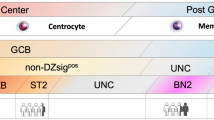Summary
Breast cancer may be more than one disease with differing etiologies. At the molecular level, breast cancer may be the result of a complex, dynamic, and stochastic process where there is more than one way to accomplish each of the steps necessary for malignant growth. The well documented biologic heterogeneity of breast cancers may arise from the many possible molecular changes that can accomplish a given step with variable efficiency. Alternatively, this heterogeneity may also reflect various possible orders of acquiring the sum of steps necessary for malignant growth.
We have attempted to describe some of the molecular changes associated with breast cancer in the context of this broad conceptual framework. We have found that the capacity for infinite growth in culture usually occurs at a late stage of malignant progression and is frequently associated with activatingras mutations. Loss of heterozygosity at chromosome 11p can occur either early or late in progression, while losses at chromosome loci 1q and 17p, although independent of each other, are found in primary breast cancers. Whether the same molecular and cellular changes are to be found in Japanese patients remains to be determined.
Similar content being viewed by others
References
Fidler IJ: Origin and biology of cancer metastasis. Cytometry 10: 673–680, 1989
Engel LW, Young NA: Human breast carcinoma cells in continuous culture: a review. Cancer Res 38: 4327, 1978
Pettengill OS, Lewko WM: Cell culture of human metastatic breast carcinomas: a review. Mol Biother 1: 122–132, 1989
Smith HS, Wolman SR, Dairkee SH, Hancock MC, Lippman M, Leff A, Hackett AJ: Immortalization in culture: Occurrence at a late stage in progression of breast cancer. J Natl Cancer Inst 78: 611–615, 1987
Weinberg RA: The action of oncogenes in the cytoplasm and nucleus. Science 230: 770–776, 1985
Land H, Parada LF, Weinberg RA: Tumorigenic conversion of primary embryo fibroblasts requires at least two cooperating oncogenes. Nature 304: 596–602, 1983
Slaga TJ, Viaje A, Bracken WM, Buty SG, Miller DR, Fischer SM, Richter CK, Dumont JN:In vitro transformation of epidermal cells from newborn mice. Cancer Res 38: 2246–2252, 1978
Colburn NH, Bruegge WF, Bates JR, Gray RH, Rossen JD, Kelsey WH, Shimada T: Correlation of anchorage-independent growth with tumorigenicity of chemically transformed mouse epidermal cells. Cancer Res 38: 624–634, 1978
Kakunaga T: Neoplastic transformation of human diploid fibroblast cells by chemical carcinogens. Proc Natl Acad Sci USA 75: 1334–1338, 1978
Stoner GD, Babcock MS, Cothern GA, Klaunig JE, Gunnig WT, Knipe SM:In vitro transformation of rat esophageal epithelial cells with N-nitroso-benzylmethylamine. Carcinogenesis 3: 629–634, 1982
Steele VE, Marchok AC, Nettesheim P: Establishment of epithelial cell lines following exposure of cultured tracheal epithelium to 12-O-tetradecanoyl-phorbol-13-acetate. Cancer Res 38: 3563–3565, 1978
Stampfer MR, Bartley JC: Induction of transformation and continuous cell lines from normal human mammary epithelial cells after exposure to benzo[a]pyrene. Proc Natl Acad Sci USA 82: 2394–2398, 1985
Chang SE, Keen J, Lane EB, Taylor-Papadimitriou J: Establishment and characterization of SV40-transformed human breast epithelial cell lines. Cancer Res 42: 2040–2053, 1982
Barbacid M:Ras genes. Annu Rev Biochem 56: 779–827, 1987
Bos JL:Ras oncogenes in human cancer: a review. Cancer Res 49: 4682–4689, 1989
Bos JL, Fearon ER, Hamilton SR, Verlaan-de Vries M, Van Boom JH, van der Eb AJ, Vogelstein B: Prevalence ofras gene mutations in human colorectal cancers. Nature 327: 293–297, 1987
Forrester K, Almoguera C, Han K, Grizzle WE, Perucho M: Detection of high incidence of K-ras oncogenes during human colon tumorigenesis. Nature 327: 298–303, 1987
Rodenhuis S, Slebos RJC, Boot AJM, Evers SG, Mooi WJ, Wagenaar SS, Van Bodegam PC, Bos JL: K-ras oncogene activation in adenocarcinoma of the lung: incidence and possible clinical significance. Cancer Res 48: 5738–5741, 1988
Bos JL, Verlaan-de Vries M, van der Eb AJ, Janssen JWG, Delwel R, Lowengerg B, Colly LP: Mutations in N-ras predominate in acute myeloid leukemia. Blood 69: 1237–1241, 1987
Rochlitz CF, Scott GK, Dodson JM, Liu E, Dollbaum C, Smith HS, Benz C: Incidence of activatingras oncogene mutations associated with primary and metastatic human breast cancer. Cancer Res 49: 357–360, 1989
Liu E, Dollbaum C, Scott G, Rochlitz C, Benz C, Smith HS: Molecular lesions involved in the progression of human breast cancer. Oncogene 3: 323–327, 1988
Callahan R, Campbell G: Mutations in human breast cancer: an overview. J Natl Cancer Inst 81: 1780–1786, 1989
Ali IU, Lidereau R, Theillet C, Callahan R: Reduction to homozygosity of genes on chromosome 11 in human breast neoplasia. Science 238: 185–188, 1987
Theillet C, Lidereau R, Escot C, Hutzell P, Brunet M, Gest J, Schlom J, Callahan R: Loss of a c-H-ras-1 allele and aggressive human primary breast carcinomas. Cancer Res 46: 4776–4781, 1986
Chen L-C, Dollbaum C, Smith HS: Loss of heterozygosity on chromosome 1q in human breast cancer. Proc Natl Acad Sci USA 86: 7204–7207, 1989
Mackay J, Steel CM, Elder PA, Forrest APM, Evans HJ: Allele loss on short arm of chromosome 17 in breast cancers. Lancet ii: 1384–1385, 1988
Author information
Authors and Affiliations
Additional information
Supported by grant P01 CA 44768 from the National Cancer Institute, National Institutes of Health, the Susan G. Komen Foundation, and the Fenton Foundation, USA
Rights and permissions
About this article
Cite this article
Smith, H.S., Chen, LC., Ngo, J. et al. Molecular and cellular lesions associated with breast cancer progression. Breast Cancer Res Tr 18 (Suppl 1), S51–S54 (1991). https://doi.org/10.1007/BF02633528
Issue Date:
DOI: https://doi.org/10.1007/BF02633528




